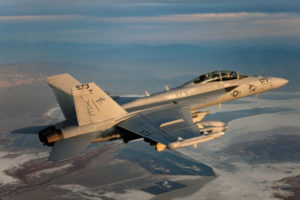
Under the FAA's new ADS-B off rule, defense aircraft such as the EA-18G Growler pictured here, can obtain authorization to turn their ADS-B Out transmissions off. Photo: Boeing
U.S. federal, state and local government aircraft performing sensitive operations are now permitted to fly with their installed automatic dependent surveillance broadcast (ADS-B) position reporting electronics turned off, according to a new rule published by the Federal Aviation Administration (FAA) Thursday.
Under the new rule, aircraft conducting operations related to homeland security, law enforcement, national defense and intelligence that could be compromised by transmitting real-time aircraft position information are permitted to disable ADS-B transmissions after obtaining proper authorization from the FAA.
Changes to the FAA's ADS-B Out airspace requirement come following several years of interagency meetings held by the FAA, Defense Department (DoD), Department of Homeland Security, Federal Bureau of Investigation and other intelligence and law enforcement agencies. Leadership from those agencies expressed strong concerns about adversaries being able to easily gain public access to real time ADS-B flight identification and positional data. A provision in the fiscal 2019 National Defense Authorization Act also prevents the FAA from mandating ADS-B installations on certain DoD aircraft.
Security concerns associated with ADS-B Out are not solely caused by the abilities of the ADS-B transponders, but instead by the proliferation and wide availability of new, inexpensive ADS-B ground receivers and applications than can track ADS-B equipped flights for 100 to 300 miles. In comparison to older Mode S transponders, ADS-B provides more detailed information including aircraft registration number, longitude, latitude, dimensions and velocity.
According to a description of the new policy, several alternatives to the new rule were considered that the FAA ultimately deemed too time consuming to meet the Jan. 1, 2020 ADS-B Out mandate, or required costly investments by DoD and other agencies. One alternative was to mask the identity of ADS-B Out equipped DoD aircraft, which defense officials determined still would not meet their needs because third parties would still be able to identify the aircraft location, velocity and altitude.
Other alternatives included the use of encryption for sensitive aircraft or a new exemption process where agencies could petition the FAA for the authority to turn ADS-B Out transmissions off. However, since no encryption solution for ADS-B currently exists and an exemption process requires agencies to submit their requests at least 120 days in advance of the exemption need, these alternatives were also decided against.
Through the rule change, the FAA has tasked its system operations security division with accepting requests from each individual agency requiring the authority to turn their ADS-B Out transmissions off. A major goal for the FAA is to avoid coordinating ADS-B Out transmission cancellations on a per-mission basis. Instead, the systems operations division will review requests submitted by the highest possibly agency organization level.
"Once an agency has determined the broad mission sets that should be excepted from the transmitting requirement using its internal policies and assessment criteria, it must contact the FAA for authorization to conduct these broad mission sets without transmitting," FAA officials wrote in the new policy statement.
While the new rule is effective immediately, the FAA is allowing comments to be submitted about the rule change through Sept. 16, 2019.
